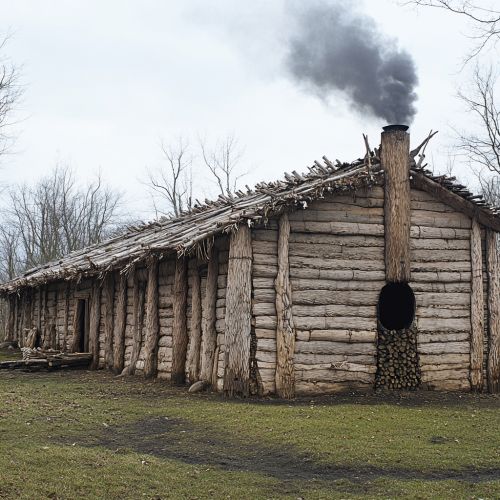Haudenosaunee: Difference between revisions
(Created page with "== Introduction == The Haudenosaunee, also known as the Iroquois Confederacy or Six Nations, is a historically powerful and influential confederation of Native American tribes. The term "Haudenosaunee" translates to "People of the Longhouse," reflecting their traditional dwellings and their cultural emphasis on community and unity. The confederacy originally consisted of five tribes: the Mohawk, Oneida, Onondaga, Cayuga, and Seneca. In the early 18th century, the Tuscaro...") |
No edit summary |
||
| (One intermediate revision by the same user not shown) | |||
| Line 8: | Line 8: | ||
The formation of the Haudenosaunee Confederacy is believed to have occurred between the 12th and 15th centuries. The tribes initially inhabited the region that is now upstate New York. Over time, their influence expanded through a combination of diplomacy, warfare, and strategic alliances. The Haudenosaunee played a significant role in the fur trade, which brought them into contact with European settlers and traders. | The formation of the Haudenosaunee Confederacy is believed to have occurred between the 12th and 15th centuries. The tribes initially inhabited the region that is now upstate New York. Over time, their influence expanded through a combination of diplomacy, warfare, and strategic alliances. The Haudenosaunee played a significant role in the fur trade, which brought them into contact with European settlers and traders. | ||
[[Image:Detail-98095.jpg|thumb|center|Traditional Haudenosaunee longhouse, constructed from wood and bark, with a smoke hole at the top.|class=only_on_mobile]] | |||
[[Image:Detail-98096.jpg|thumb|center|Traditional Haudenosaunee longhouse, constructed from wood and bark, with a smoke hole at the top.|class=only_on_desktop]] | |||
== Governance and Social Structure == | == Governance and Social Structure == | ||
Latest revision as of 09:24, 24 September 2024
Introduction
The Haudenosaunee, also known as the Iroquois Confederacy or Six Nations, is a historically powerful and influential confederation of Native American tribes. The term "Haudenosaunee" translates to "People of the Longhouse," reflecting their traditional dwellings and their cultural emphasis on community and unity. The confederacy originally consisted of five tribes: the Mohawk, Oneida, Onondaga, Cayuga, and Seneca. In the early 18th century, the Tuscarora joined, making it the Six Nations.
Historical Background
The origins of the Haudenosaunee Confederacy are deeply rooted in oral tradition, which recounts the story of the Great Peacemaker, a prophet who united the warring tribes under a single framework of governance known as the Great Law of Peace. This law established a democratic system that emphasized collective decision-making and the importance of consensus.
Formation and Expansion
The formation of the Haudenosaunee Confederacy is believed to have occurred between the 12th and 15th centuries. The tribes initially inhabited the region that is now upstate New York. Over time, their influence expanded through a combination of diplomacy, warfare, and strategic alliances. The Haudenosaunee played a significant role in the fur trade, which brought them into contact with European settlers and traders.


Governance and Social Structure
The Haudenosaunee Confederacy is renowned for its sophisticated system of governance, which predates the United States Constitution and has been cited as an influence on American democratic principles.
The Great Law of Peace
The Great Law of Peace is the constitution of the Haudenosaunee Confederacy. It outlines the roles and responsibilities of the leaders, known as sachems, and the procedures for decision-making. The law emphasizes the importance of peace, equity, and collective responsibility.
Clan System
The Haudenosaunee society is matrilineal, meaning that lineage and inheritance are traced through the mother's line. Each tribe is divided into clans, each represented by an animal such as the Bear, Wolf, or Turtle. Clan membership plays a crucial role in social organization, marriage, and leadership selection.
Cultural Practices
The Haudenosaunee have a rich cultural heritage that includes a variety of ceremonies, oral traditions, and artistic expressions.
Ceremonies and Festivals
Key ceremonies include the Midwinter Ceremony, which marks the beginning of the new year, and the Green Corn Festival, which celebrates the harvest. These ceremonies often involve singing, dancing, and the use of sacred objects.
Oral Tradition
Oral tradition is a cornerstone of Haudenosaunee culture. Stories, legends, and historical accounts are passed down through generations, preserving the collective memory and values of the people.
Arts and Crafts
Haudenosaunee artisans are known for their beadwork, pottery, and basketry. Wampum belts, made from shell beads, are particularly significant as they are used to record treaties and important events.
Interactions with Europeans
The arrival of Europeans in North America had a profound impact on the Haudenosaunee. Initially, the confederacy engaged in trade with the French, Dutch, and English, exchanging furs for goods such as metal tools and firearms.
The Beaver Wars
During the 17th century, the Haudenosaunee were involved in the Beaver Wars, a series of conflicts primarily fought over control of the fur trade. These wars expanded their territory but also led to significant loss of life and disruption.
Treaties and Alliances
The Haudenosaunee entered into various treaties with European powers, including the Covenant Chain with the British. These alliances were strategic, aimed at preserving their autonomy and securing trade advantages.
Modern Era
In the contemporary period, the Haudenosaunee continue to maintain their cultural identity and political sovereignty. They are active in advocating for their rights and preserving their traditions.
Political Activism
The Haudenosaunee have been involved in various political movements, advocating for land rights, environmental protection, and the recognition of treaties. They have also played a role in international forums, such as the United Nations, to promote indigenous rights.
Cultural Revitalization
Efforts to revitalize Haudenosaunee culture include language preservation programs, cultural education initiatives, and the revival of traditional ceremonies. These efforts aim to ensure that future generations remain connected to their heritage.
